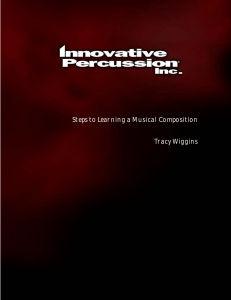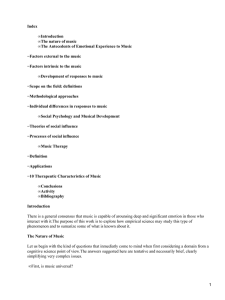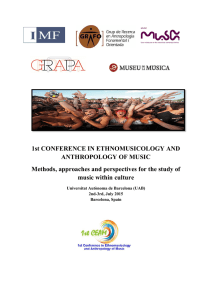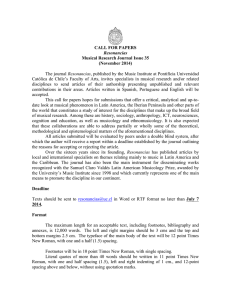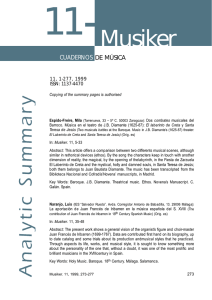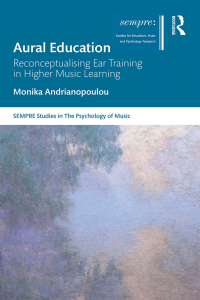Guía Docente de Informática Aplicada
Anuncio
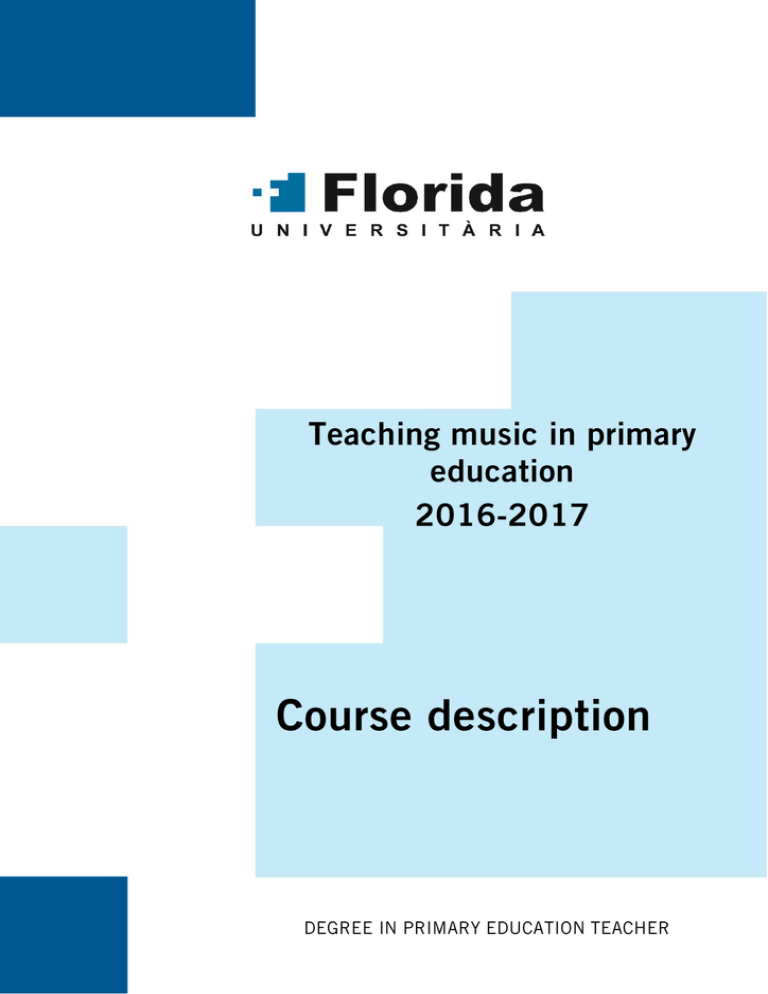
INDEX IndEX 1. Identification Subject: Subject/Module: Type of module ETCS: Degree Level/term: Department Teachers: Language 2. Description and general objectives 3. Requirements. 4. Competences. 5. Learning outcomes. 6. Training activities and methodology. 7. Syllabus. 8. Assessment methods 9. Students in special situations Students who do not attend class regularly for a particular situation (work, health...) will have to perform some specific actions to overcome the subject. These students must develop all the activities that are required. The activities will be sent by email according with the agreements reached with the teacher. 10. Annotated bibliography and references. Basic bibliography 11. Special regulations 12. Office hours Identification Subject: Subject/Module: Type of module ETCS: Degree Level/term: Department Teachers: Teaching music in primary education Subject Core subject 6 Primary teacher education Level 1 / 1st and 2nd term Music/ Education Jose Rafael Adell Valero radell@florida-uni.es Office: D.3.7. Office hours: Language - 1st Semester: Thursday 10:15 – 11:15 h. - 2nd Semester: Friday 11:45-12:45 h. - By appointment English (and Catalan) 1. Description and general objectives This theoretical and practical course wants to show how to teach music. The main aim is familiarize students with the world of education through musical activities, working concepts using its mediator elements as: active listening, movement, voice and musical instruments. The application of new methodologies and procedures teaching music is one of the most important elements in this subject. The general objectives are: Understand the basics of Music Teaching mentioned in the curriculum of primary education, empowering students to acquire the knowledge required for the subject and strategies to develop their future teaching work. Provide an active methodology for the development of music education of children. Acquiring basic knowledge of the subject and contents worked on developing the skills: perception, hearing, speech and creation. 2. Requirements. There are no specific requirements. 3. Competences. FLORIDA UNIVERSITARIA’S COMPETENCES G1. ICT G2. Oral Communication G3. Written Communication G4. Foreign language fluency G5. Team-working G6. Conflict solving G7. Long-life learning G8. Commitment and ethics G9. Innovation and creativity G10. Leadership BASIC AND GENERAL COMPETENCES A. Express correctly and adequately orally and writing in the both official languages of the Autonomous Community. B. Use with solvency information technology and communication as regular working tools. C. Analyze critically and incorporate the most relevant issues of contemporary society that affect the family and school education: social and educational impact of audiovisual languages and screens; changes in gender relations and intergenerational; multiculturalism and interculturalism; discrimination and social inclusion and sustainable development; and promote educational actions aimed at the preparation of an active and democratic citizenship. D. Promote cooperative work and individual effort. E. Assume that the exercise of teaching profession must be adapted to scientific, educational and social life long changes. F. Understand the processes of interaction and communication in the classroom. G. Recognize the identity of each stage and its cognitive, psychomotor, communicative, social and emotional impact. H. Design, plan and evaluate teaching and learning in the classroom in multicultural contexts. I. know how to work in teams with other professionals within and outside the center in the attention to each student, as well as in planning learning sequences and in organizing work situations in the classroom and on the playing space. J. Know and apply methodologies and basic techniques of educational research and be able to design innovative projects identifying evaluation indicators. K. Understand that systematic observation is a basic tool to reflect practice and reality and contribute to innovation and improving education. L. Identify and plan the resolution of educational situations involving students with different capacities and different rates of learning and acquire resources to promote their integration. SPECIFIC COMPETENCES E1 Ability to appreciate the educational value of music. E2 Ability to recognize the constituent elements of music. E3 Ability to do individual and group singing. E4 Ability to achieve autonomy in reading simple melodies. E5 Ability to develop rhythmic sense and their coordination. E6 Ability to develop vocal expression and movement. E7 Ability to promote creativity, improvisation and acting ability. E8 Ability to synchronize voice, movement and instrumental performance. E9 Ability to get to know and practicing school instruments. E10 Ability to discover the elements of musical language from active musical audition. 4. Learning outcomes. LEARNING OUTCOMES Students will be able to: R1 Understand and identify the fundamental ideas of the subject. R2 Integrate the knowledge acquired in the current social and cultural context. R3 Develop educational resources appropriate to the stage and promote learning related to music education. R4 Recognize and value the importance of training in music education as a base for their personal development and in the classroom. R5 Understand the fundamentals and development of teaching music. Be able to make adjustments that allow access to all the children to enjoy music and use it as a way of expression. R6 Know how to use the game as didactic element to introduce musical contents. R7 Be aware of the thematic elements from a perceptive analysis of listening, making documents, diagrams and scores. R8 Learn the basics of music theory, vocal and instrumental technique, harmony, rhythm and dance. R9 Learn the techniques of representation of musical language. R10 Analyse the content acquired in practice sessions and relate them to theory. R11 Be able to present the results of the activities developed in classroom. R12 Develop skills to work individually and in groups. R13 Enhance communication skills with other students, the teacher and experts and professionals who can help. 5. COMPETENCES G7 G9, E1 G7, G9 E1 E1 E1, E5, E6, E7 E2, E10 E2, E3, E5, E6, E8, E9 E2, E4 E2, E7, G7 G2, G3, G7 G5, G6, G9, G10 G2, G3, G7 Training activities and methodology. The workload of students in the course is equivalent to 25 hours for each credit. So according to the value of 6 credits stipulated for the subject, the total of hours is 150. This workload is split in: Classroom training activities (theoretical and practical classes, seminars, projects, tutoring...). 60 hours. Autonomous work and study (study and lesson preparation, training activities, preparation of exercises, projects, lectures and exam...): 90 hours. According to what has been presented, the work is distributed among the following activities and percentages of application: IN- CLASS ACTIVITIES Teaching model Methodology Relationship with learning outcomes Percentage THEORICAL LECTURES Content explanation necessary for the proper development of the subject by teachers. Application activities. R1, R4, R3, R8, R9, R10 15-25% (15h) PRACTICAL LECTURES Group sessions for practical music aspects: rhythm, percussion, recorder, singing, movement, listening… R2, R3, R6, R7, R10, R11, R12, R13 50% (30h) TEAMWORK Project. R2, R3, R12, R13 25% (15h) MENTORING HOURS Personalized attention in small groups to review and redirect learning and work. R6, R7, R8, R9, R10 0-10% (6h) (optional) 100% Total HOMEWORK ACTIVITIES. Teaching model Relationship with learning outcomes Percentage TEAMWORK Musical pieces preparation to work in class. Projects and activities that will be exposed in class. R2, R11, R12, R13 44’4% (40h) INDIVIDUAL Personal study of songs (singing and playing with recorder). Study of theoretical content. R1, R3, R4, R5, R6, R7, R8, R9, R10 55’5% (50h) Methodology Total 100% The communication language in class will be English but some activities could be conducted in Catalan (or mixing) if it’s necessary for better comprehension. 6. Syllabus. The course is divided into two blocks, the contents are summarized below: 1. Theoretical content: SOUND: • Qualities of sound: pitch, duration, intensity and timbre. • Auditory discrimination: stimulating sensory, perception and representation. MUSICAL LANGUAGE ELEMENTS: The rhythm: -Rhythm. -Tempo. -Rhythm types: binary, ternary and quaternary. -Elementary rhythmic structures. -Adequacy text – rhythm. -Rhythmic accompaniments. Melody: -Major and minor scales. -The Melodic line and its structure. -Structure: ask – answer. Suspensive and conclusive sense. -Tonality and modality. The sharp, the flat and the natural. Harmonia: -Chord concept. Grades: I - IV and V. -Final cadence concept. • Primary Curriculum: Teaching music: - Contents. - Objectives. - Basic competences. Agogics and dynamics: -Tempo variations. -Intensity variations. Musical form: -Eco, ostinato, phase. -Elemental structures: canon, lied and rondo. Musical instruments: - Classification. - School Instruments. - Other instruments: popular, homemade, digital… MEDIATOR ELEMENTS: Voice: The voice in the classroom: -Introduction to vocal technique. -How to teach a song. -One or two voices singing. • Movement: The movement in the classroom: -Introduction to the technique of motion. -Teaching music and movement. -Choreography. • Instruments: The instruments in the classroom: -Introduction to instrumental technique. -How to teach using instruments. -Instrumentals families. • Musical audition: Music. Active audition: -Introduction to teaching hearing. -Active musical audition. -Audition and musical language. -Symbolic systems of musical representation. 2. PRACTIC CONTENTS: - Practical application of sound qualities. - Rhythmic and melodic activities using simple measures: 2/4, 3/4 and 4/4. - Discrimination exercises: auditory, rhythmic and melodic. - Melodies interpretation with recorder and Orff instruments. - Improvisation of elementary rhythmic structures. - Practical application of the intensity (dynamics). - Development of rhythmic structures through movement. - Active listening. - Activities about musical form elements: echo, ostinato, question-answer structure and musical phrase. - Analysis and interpretation of basic musical forms: canon, rondo and lied. - Activities to use properly the voice (speaking or singing). - Play simple instrumental accompaniment in a song. TRAINING TASKS SESSIONS LEARNING OUTCOMES UNITS (HOURS) Play recorder R4, R5, R8 Practic contents 4 Sing popular songs R4, R5, R8 Practic contents 4 UNITS TRAINING ACTIVITIES Nº OF SESSIONS (Hours) Unit 1 Qualities of sound: 1 -Pitch, intensity, duration and timbre. Unit 2 Unit 3 Unit 4 Unit 5 Unit 6 Unit 7 Unit 8 Unit 9 Unit 10 Unit 11 Unit 12 Tema 13 Rhythm : -Rhythm. -Tempo. -Rhythm types: binary, ternary and quaternary. -Elementary rhythmic structures. -Adequacy text – rhythm. -Rhythmic accompaniments. Melody: -Major and minor scales. -The Melodic line and its structure. -Structure: ask – answer. Suspensive and conclusive sense. -Tonality and modality. The sharp, the flat and the natural. Harmonia: -Chord concept. Grades: I - IV and V. -Final cadence concept. • Primary Curriculum: Teaching music: - Contents. - Objectives. - Basic competences. Agogics and dynamics: -Tempo variations. -Intensity variations. Musical form: -Eco, ostinato, phase. -Elemental structures: canon, lied and rondo. Musical instruments: - Classification. - School Instruments. - Other instruments: popular, homemade, digital… Voice: The voice in the classroom: -Introduction to vocal technique. -How to teach a song. -One or two voices singing. • Movement: The movement in the classroom: -Introduction to the technique of motion. -Teaching music and movement. -Choreography. • Instruments: The instruments in the classroom: -Introduction to instrumental technique. -How to teach using instruments. -Instrumentals families. • Musical audition: Music. Active audition: -Introduction to teaching hearing. -Active musical audition. -Audition and musical language. -Symbolic systems of musical representation. Symbolic systems of musical representation. 1 1 1 1 1 1 1 2 1 1 2 1 PRACTIC Nº OF SESSIONS TRAINING ACTIVITIES TOPICS (Hours) P1 - Didactic activities about the qualities of sound. 1 P2 - Practical application of sound qualities. - Rhythmic and melodic activities using de measures: 2/4, 3/4 and 4/4. 1 - Improvisation of simple rhythmic structures. - Discrimination exercises: auditory, rhythmic and melodic. P3 P4 1 1 P5 - Interpretation of a song with Orff instruments, using simple harmonic criteria. - Plan a didactic unit. P6 - Auditory discrimination exercises: tempo and dynamics. 1 P7 P8 P9-11 1 - Practical application of tempo and dynamics. - Musical form activities: eco, ostinato, question-answer structure and musical phase. - Analysis and interpretation of basic musical forms: canon, rondo and lied. - Practice songs with simple instrumental accompaniments. 2 2 10 - Melodies interpretation with recorder and Orff instruments. P12-14 7. - Activities for appropriate use of singing voice. 6 P15 - Development of melodic and rhythmic structures through movement. 2 P16 - Active listening. 2 TW - Teamwork 15 Assessment methods Evaluation System ASSESSMENT AND QUALIFICATION SYSTEM Grading procedures Written test (multiple-choice test) Practical test: singing recorder . Production and oral work. Teamwork and Learning outcomes Percentage R1, R7, R8, R9, R10 30% R2, R3, R4, R5, R6, R11, R12 45% R2, R3, R12, R13 25% playing Marking. 1st CALL 2on CALL The evaluation will be continuous, taking into account the practices in all sessions of the course and the work entrusted. It will be necessary to pass both parts of the evaluation: written exam and assignments. All the students who can’t attend class for justified reasons must notify the teacher in order to find an alternative way to make up for the lack of attendance. The evaluation process will consider the following factors: -Theoretical and practical works developed along the course. -Work presentation. - Active participation in the class. -Written multiple-choice test about the theoretical contents worked in class. -Practice test based on the musical dossier worked in class: singing and playing recorder. -Correct oral and written expression. -Correct Interpretation of songs. 8. Students in special situations Students who do not attend class regularly for a particular situation (work, health...) will have to perform some specific actions to overcome the subject. These students must develop all the activities that are required. The activities will be sent by email according with the agreements reached with the teacher. The ideal situation is that the students will take the same written and practical tests than the rest of the class for their final assessment. If not possible, the teacher and the student have to make an agreement in order to perform a way to overcome the subject. It will be necessary that those who, by their personal situation, should know that they will not be able to attend class, advise as soon as possible and get in touch with the teacher in order to deal an action plan. 9. Annotated bibliography and references. Basic bibliography AAVV. (2003) Eufonía Didáctica de la música, nº 27. La música a partir de diferentes contextos de trabajo. Alonso, V. (1996). Sonidos y ritmos. Educación primaria (LOGSE). Libro del Profesor. Cuadernos del alumno, niveles I y II. Valencia: Rivera Editores. Alonso, V. (1998). Sonidos y ritmos. Educación primaria (LOGSE). Libro del Profesor. Cuadernos del alumno, niveles III y IV. Valencia: Rivera Editores. Aymerich, C. (1971). Expresión y arte en la escuela. Madrid: Teide. Barrientos, E. (1985) La flauta dulce. Barcelona: de Vecchi. Bort, A. y otros (1986). Siringa. Método de flauta. Valencia: Tándem. Cateura, M. (1982). Música para los ciclos básicos. Niveles I, II, III, IV. Barcelona: Daimon. Dalcroze, J. (1965). El ritmo, la música y la educación. Lausana: Freres S.A. Delalande, F. (1995). La música es un juego de niños. Buenos Aires: Ricordi Americana. Elizalde, L. (1991). Flauta dulce. Madrid.: Publicaciones Claretianas. Ferrero, I, y otros (1980). Planteamiento de la enseñanza musical. Buenos Aires: Ricordi. González, L. (1982). La expresión sonora. Valladolid: Miñón. Graetzer, G. y Yepes, A. (1961). Introducción a la práctica del Orff Schulwerk. Buenos Aires: Barry. Hurtado, J. y E. Llopis (2004). REPERTORI 1. Valencia: Voramar-Santillana. Hurtado, J. y E. Llopis (2004). REPERTORI 2. Valencia: Voramar-Santillana. Hurtado, J. y E. Llopis (2005). REPERTORI 3. Valencia: Voramar-Santillana. Károlyi, O. (2002). Introducción a la música. Ed: Alianza Editorial. Martin, C. (1992). Vive la música. Educación primaria. Niveles I, II, III. Barcelona: Octaedro, S.L. Oriol, N. y Parra, J.M. (1979) La expresión musical en la educación básica. Madrid: Alpuente SA. Pérez-Gil, M. (2004) Lenguaje musical para maestros. Valencia: Asaigredo. Riu, N. (2000). El lenguaje musical. Propuestas didácticas para los tres ciclos de Primaria. Barcelona: Ceac. Schafer, M. (1982). Limpieza de oídos. Buenos Aires: Ricordi. Schafer, M. (1998). El nuevo paisaje sonoro. Santander: Ricordi Americana. Schafer, M. (2008). El rinoceronte en el aula. Buenos Aires: Melos. Willems, E. (1979). El ritmo musical. Edt.: Eudeba. Buenos Aires. Wuyttack, J. (1993). Cantar y descansar. Edt.: Real Musical. Madrid. Wuyttack, J. (1994). Cantan y bailan. Edt.: Nau Llibres. Valencia. Music magazines EUFONÍA. Didáctica de la Música, editada per Graó. Barcelona. MÚSICA Y EDUCACIÓN, editada per Musicalis S.A. Madrid. BOLETÍN DE INVESTIGACIÓN EDUCATIVO MUSICAL DEL CIEM Centro de Investigación en Educación Musical de Buenos Aires, Argentina. BOLETÍN DE LA SOCIEDAD PARA LA EDUCACIÓN MUSICAL DEL ESTADO ESPAÑOL. SEM EE, MELÓMANOS DOCE NOTAS LÉEME. Revista electrónica de educación musical 10. Special regulations Specific rules The classes will be developed in the laboratory of music (basement of building A) and start sharp o’clock. It is necessary to be on time for the good running of the program. The duration of the classes is 2 hours. The material used in the classroom (instruments, paper crafts materials…) should be collected and ordered at the end of classes; all students must participate in this process. 11. Office hours 1st Semester: Thursday 10:15 – 11:15 h. In music class or in Office: D.3.7 2nd Semester: Friday 11:45-12:45 h. In music class or in Office: D.3.7. It’s possible to arrange a meeting with the teacher by email out of the timetable.
